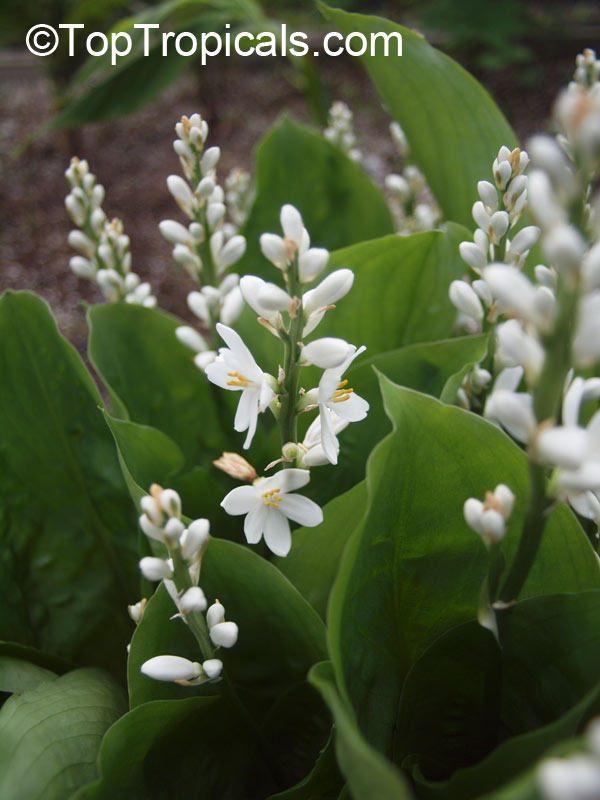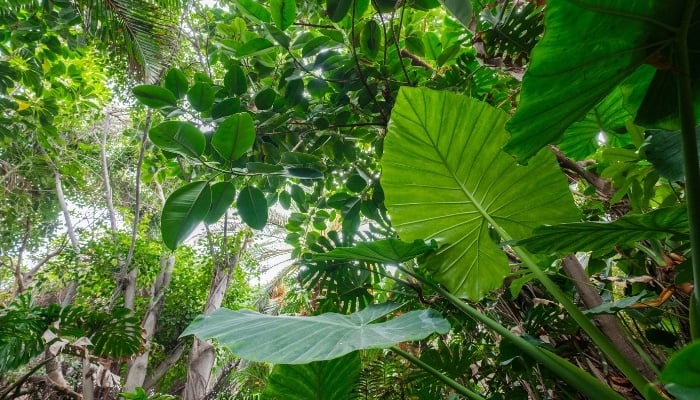Collectors frequently search for rare rainforest plants due to their scarcity.
However, these plants have become mainstream because they make beautiful, intriguing houseplants.
Read on to learn more about some of these most striking plants, ranging from the largest flower in the world to plants whose leaves appear to be plastic.
1. Pink Princess Philodendron (Philodendron erubescens)
While P. erubescens is not particularly rare, the Pink Princess variegation is in high demand relative to supply. Rarely occurring in nature, the mottled hot pink coloring is hard to come by.
Even when grown from tissue culture, “the plant can not be reliably propagated to guarantee pink variegation, even if the mother plant is already heavily variegated with pink.”
Pink Princess Philodendrons make good houseplants, growing to about 2-4 feet tall. They take some extra effort because the pretty pink parts lack chlorophyll, which means some pruning may be necessary to keep the plant from dying.
Erubescens, in general, is native to Central and South American rainforests, but this rare hybrid has only been cultivated since the 1970s, probably originating in Florida.
The Pink Princess Philodendron is on the expensive side, with costs around $100-200, on average.
2. Pitcher Plant (Nepenthes spp.)
The Nepenthes genus of pitcher plants refers to around 140 known species mostly native to Southeast Asia, Madagascar, and northern Australia. They are carnivorous, luring and then digesting insects in their “pitcher” filled with digestive enzymes.
Though first written about by Charles Darwin in 1875, new species of these rare rainforest plants are still being discovered or artificially hybridized by collectors. Besides the common pitcher feature, the species vary widely regarding size, preferred elevation, and appearance.
Commonly collected and cultivated species are the N. alata and N. sanguinea. Both are similar in size (between 6 and 12 inches tall), but the colors range from deep purple to yellow-green.
The largest Nepenthes species is the N. attenboroughii, nearly 5 feet tall and can eat small animals such as mice.
According to the Guinness World Record, the most expensive Nepenthes ever sold was a N. rajah x N. peltata hybrid sold in 2019 for $4,500. For comparison, the average price for a less rare pitcher plant is up to $200.
To qualify rarity another way, some of the most critically endangered species are the N. clipeata, N. pitopangi, and N. rigidifolia.
3. Giant Water Lily (Victoria amazonica)
The giant water lily (AKA Amazon water lily) is a true giant, with a floating leaf diameter of up to 8-10 feet and an underwater stalk up to 26 feet long. Apart from its size, the giant water lily also stands out for how quickly it grows, “expand[ing] by up to 20 inches per day.”
It was first discovered in 1801 in Bolivia and is native to the Amazon river. This plant is rare because it needs to grow in still, shallow waters and warm temperatures. In fact, despite its gigantic surface area, the giant water lily does best in just 1-3 feet of water.
The average price of these difficult lilies is only between $2-3 for the seeds, despite the plant’s rarity.
4. Tropical Lily of the Valley (Peliosanthes javonica)

The tropical lily of the valley is an extremely rare rainforest plant. It is difficult to find information regarding species in the Peliosanthes genus, much less to purchase the plant. What is known is that the plant is native to southeast Asia, is relatively small, and typically grows on land.
However, it can tolerate flooded soil or even being submerged in water for some time.
5. Monkey Brush Vine (Combretum rotundifolium)
The monkey brush vine grows in South America, especially along riverbanks, and has a unique, bright-red “brush” appearance. The shrub can grow to nearly 20 feet tall, while the “brush” spikes found on the ends of the shrub’s upper leaves are 1-3 cm long.
While hard to find to purchase, monkey brush vines sell for around $75-100. It is also used as traditional medicine by locals. However, there is not much evidence of the vines’ cultivation.
6. Black Gold Philodendron (Philodendron Melanochrysum)
The black gold philodendron is widely cultivated yet still relatively expensive and rare because of its attractive foliage.
The black gold philodendron is a climbing vine plant that grows very large, dark-green leaves with bright white veins. It typically grows about 1-3 feet tall as a houseplant, but the leaves can grow to almost 2 feet long.
This rare rainforest plant is native to South America and appreciates warm climates and high humidity. It can be purchased for around $40-100+ and is readily available, especially compared to some other plants found on this list.
7. Rafflesia Flowers (Rafflesia arnoldii)
Often referred to as corpse or stinking corpse flowers, Rafflesia flowers are known for being the world’s largest flowers, at more than 3 feet across, and for smelling like rotting meat at specific growth stages. Unlike the other widely known “corpse flower” (Titan arum), Rafflesia flowers have yet to be cultivated and are giant parasites in the wild.
Other unique characteristics of this rare plant are that carrion flies pollinate it, it gives off heat, and it features spiky structures which have no known purpose. Furthermore, rafflesia flowers are incredibly interesting genetically.
Scientists have found that these parasitic plants acquire genes from their host, known as “horizontal gene transfer, the exchange of genetic information between two organisms without sex.” Simply put, horizontal gene transfer doesn’t normally take place in complex organisms, especially not to the extent that it does in rafflesia flowers.
While seeming otherworldly, rafflesia flowers are found in southeastern Asian rainforests. The earliest recorded discovery by Europeans was in 1797.
8. King Anthurium (Anthurium veitchii)
King anthurium plants are notable for their massive leaves–sometimes growing to over 3 feet in length when kept indoors or over 6 feet in the wild.
Originally native to Colombian rainforests and so prefer warm, humid climates, they are now popular houseplants. Their long green leaves almost appear “quilted” because of the veins’ pattern across the leaf.
Now relatively common among collectors, the king anthurium still sells for about $70-200+.
9. Gray Dragon Alocasia (Alocasia maharani)
The gray dragon alocasia is sought after for its unique foliage which is intricately textured, leathery, and unusually gray-green in color. This plant comes from southeast Asian rainforests, where it gets direct sunlight on the rainforest floor.
Sometimes called a “Jewel Alocasia,” the gray dragon alocasia makes a good houseplant for its small size (up to two feet tall) and decorative texture. This rare rainforest plant is a hybrid species of A. reginula x A. melo and sold for around $20-30.
10. Brazilian Bell Flower (Abutilon megapotamicum)
The Brazilian Bell Flower, also known as the Trailing Abutilon, comes from Brazil and stands out for its Chinese lantern-like red-and-yellow flowers. The shrubs grow up to 2-6 feet tall and 3-5 feet wide, while the flowers measure about 2 inches across.
They are relatively popular and easily found and sell for $15-30.
11. Billietiae Philodendron (Philodendron billietiae)
The billietiae philodendron is considered the rarest philodendron and comes from Central American rainforests. Nowadays, it is a popular indoor vine houseplant with long, dark green leaves and orange stems.
The billietiae philodendron can grow up to 9 feet tall but generally is about 4.5 feet tall. They can be found for around $75-100, but their variegated mutation’s price skyrockets to thousands of dollars.
The difference between the varieties is simply an attractive and rare leaf patterning.
12. Window Leaf Monstera (Monstera obliqua)
The Window Leaf Monstera is very rare, but your local greenhouse might think they have one, which is because the M. obliqua very closely resembles M. adansonii for years before one can tell them apart. The difference is that the Window Leaf Monstera is even more fragile than its counterpart–obliqua is “extremely fenestrated to the point that there is more hole than leaf.”
Coming from Central and South American rainforests, this rare rainforest plant is so rare because it grows extremely slowly. It’s also delicate by definition because its leaves are so perforated and thin. Otherwise appearing like a typical member of the Monstera genus, M. obliqua gradually develops its numerous holes as it matures.
A true obliqua can sell for as much as $23,000. They will at least cost you thousands, and if they don’t, it is likely a scam to get you to unknowingly buy a much less rare adansonii.
13. Crystal Laceleaf (Anthurium crystallinum)
Crystal laceleaf plants stand out for their striking foliage. They have dark green, heart-shaped leaves with bright white veins and a velvety texture. They are native to Central and South American rainforests and are somewhat difficult to care for because of their native tropical habitat.
Crystal laceleaf plants vary widely in price. They can sell for as low as $15 or as high as well over $100, which is because they grow very slowly (i.e., larger sizes are much more valuable), yet even the largest among them are good houseplants standing around one foot tall.
14. Elephant Ear (Alocasia zebrina)
Elephant ear plants are convenient houseplants for their small size (up to 3 feet tall) and attractive zebra-like patterning on the stems. They come from the Philippines originally and have become rare because of overcollection.
However, these plants are relatively affordable, costing around $25-50. They have arrowhead-shaped dark green leaves and are somewhat temperamental.
15. Voodoo Lily (Amorphophallus konjac)
The voodoo lily gets its name from the appearance and pungent odor of its flower, which is intended to attract carrion flies to pollinate the plant. At other growth stages, this eastern Asian plant can produce edible tubers and also resemble a tree up to 4-6 feet tall.
These tubers are toxic if eaten raw, but voodoo lilies are nonetheless widely cultivated in China and Japan for their decorative dark purple flower color as well as their tuber’s edibility.
These relatively procurable plants typically sell for around $20.

